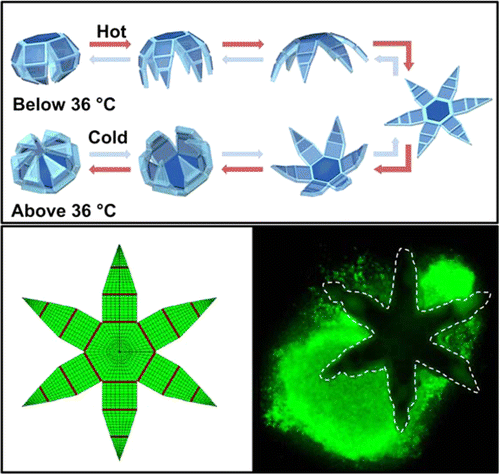Tiny robotic 'hands' could improve cancer diagnostics, drug delivery

Many people imagine robots today as clunky, metal versions of humans, but scientists are forging new territory in the field of 'soft robotics.' One of the latest advances is a flexible, microscopic hand-like gripper. The development could help doctors perform remotely guided surgical procedures or perform biopsies. The materials also could someday deliver therapeutic drugs to hard-to-reach places. The report appears in the journal ACS Applied Materials & Interfaces.
David H. Gracias and colleagues note that many robotic tools require cords to provide power to generate their movements. But cords add to the bulk of robots, which limits the spaces they can access. To address this constraint, scientists have turned to hydrogels. These soft materials can swell in response to changes in temperature, acidity or light, providing energy to carry out tasks without being tethered to a power source. However, hydrogels are too floppy for some applications, so the group combined the hydrogels with a stiff biodegradable polymer, making the microhands strong enough to wrap around and remove cells. The team then sought a way to control where the grippers go once deployed in the body.
The researchers incorporated magnetic nanoparticles in the materials so they could guide the microhands with a magnetic probe. The team concluded that this added trait could help in the microassembly or microengineering of soft or biological parts, or give surgeons the ability to remotely direct where biopsies are taken. Also, Gracias says that the use of soft materials highlights the possibility of creating biodegradable, miniaturized surgical tools that can safely dissolve in the body (Watch a video of the grippers here).
More information: Self-Folding Thermo-Magnetically Responsive Soft Microgrippers, ACS Appl. Mater. Interfaces, Article ASAP. DOI: 10.1021/am508621s
Abstract
Hydrogels such as poly(N-isopropylacrylamide-co-acrylic acid) (pNIPAM-AAc) can be photopatterned to create a wide range of actuatable and self-folding microstructures. Mechanical motion is derived from the large and reversible swelling response of this cross-linked hydrogel in varying thermal or pH environments. This action is facilitated by their network structure and capacity for large strain. However, due to the low modulus of such hydrogels, they have limited gripping ability of relevance to surgical excision or robotic tasks such as pick-and-place. Using experiments and modeling, we design, fabricate, and characterize photopatterned, self-folding functional microgrippers that combine a swellable, photo-cross-linked pNIPAM-AAc soft-hydrogel with a nonswellable and stiff segmented polymer (polypropylene fumarate, PPF). We also show that we can embed iron oxide (Fe2O3) nanoparticles into the porous hydrogel layer, allowing the microgrippers to be responsive and remotely guided using magnetic fields. Using finite element models, we investigate the influence of the thickness and the modulus of both the hydrogel and stiff polymer layers on the self-folding characteristics of the microgrippers. Finally, we illustrate operation and functionality of these polymeric microgrippers for soft robotic and surgical applications.
Journal information: ACS Applied Materials and Interfaces
Provided by American Chemical Society



















